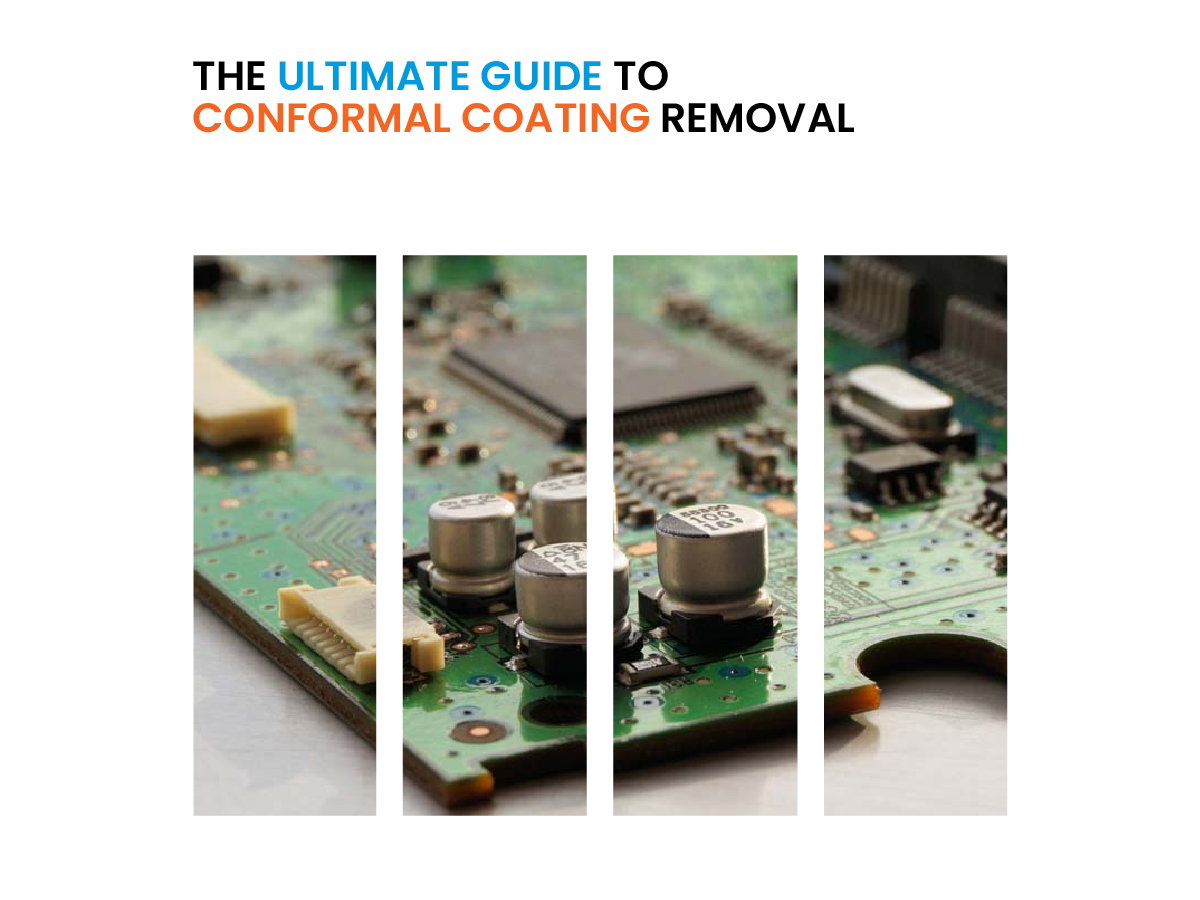
Looking for an ultimate guide on conformal coating removal?
We’ve compiled all the latest technical resources and standards to make your next PCB rework and repair job a breeze whether you’re working with Acrylic, Epoxy, Silicone, Parylene or Urethane. Enjoy!
To jump to a specific area, click the section below.
Types of Conformal Coating
How to Identify Which Conformal Coating is on the PCB
Recommended Removal Methods for Specific Types of Conformal Coating
Chemical Solvent Method for Conformal Coating Removal
Peeling Method for Conformal Coating Removal
Thermal Method for Conformal Coating Removal
Grinding and Scraping Method for Conformal Coating Removal
How To Remove Conformal Coating Using a Micro Sandblaster
Tools for Conformal Coating Removal
VIDEO: Removal of Conformal Coating with a Vaniman Sandblaster
Free quick-reference guide:
Types of Conformal Coating
There are five types of conformal coatings, with four primary methods in which they are applied. All coatings can be sprayed by hand or spray booth.
Some coatings can be applied manually using a brushing method; however, this requires an experienced hand. Dipping is a very common application method, performed manually or by a machine but is limited to slow-curing chemicals.
Lastly, robotic-applied coatings can be used for all coatings with proper tooling if you have the provided equipment or use a conformal coating company.
Acrylic Resins (AR)
- Smooth glossy finish.
- Good for long-term defense against moisture.
- Usually applied by being brushed, sprayed, or dipped manually or by machine.
Epoxy Resins (ER)
- Smooth hard surface.
- Good against moisture, temperature, and abrasion.
- Resists chipping, peeling, or cracking.
- Usually applied by being brushed, sprayed, or dipped manually or by machine.
Silicone Resins (SR)
- When cured, is rubbery and pliable.
- Excellent against humidity, corrosion resistance, and extremely high temperatures.
- Usually applied by being brushed, sprayed, or dipped manually or by machine
Parylene (XY)
- Uniform contour of PCB, can be thick or thin.
- Low thermal expansion, good abrasion resistance, and outstanding chemical resistance.
- Approved by FDA in medical applications
- Applied using Chemical Vapor Deposition (CVD) machine.
Polyurethane Resins (UR)
- Uniform contour of PCB, can be thick or thin.
- Approved by FDA in medical applications
- Urethane is excellent at chemical resistance and good for applications needing protection from prolonged chemical exposure.
- Usually applied by being brushed, sprayed, or dipped manually or by machine.
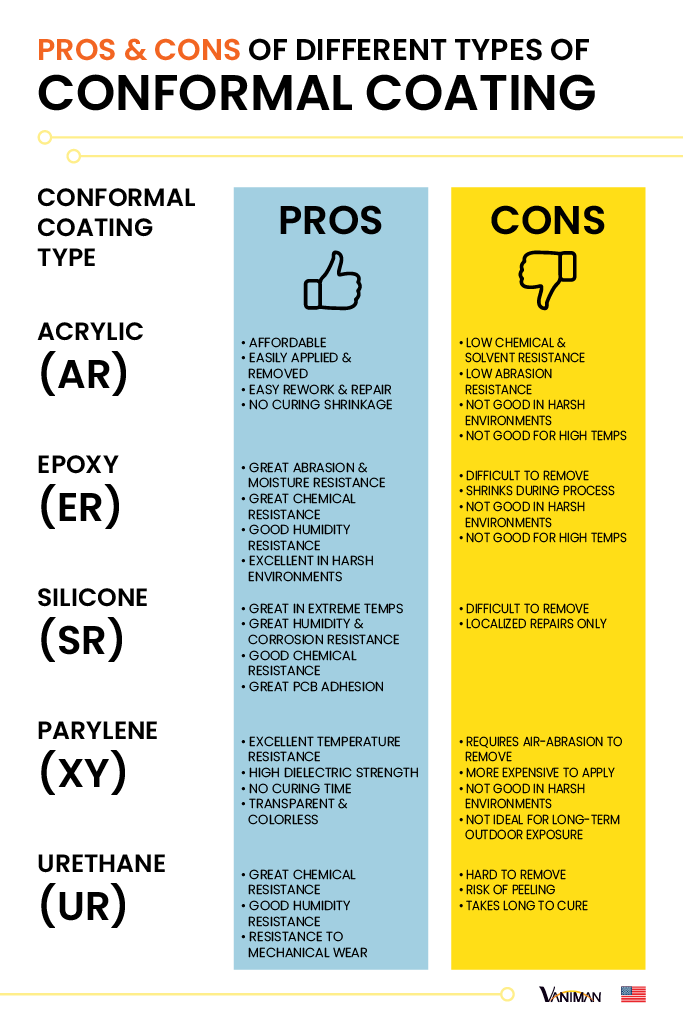
How to Identify Which Conformal Coating is on the PCB
Before selecting a conformal coating removal method, you must first identify which coating was used. You can obtain this information from the initial source that applied the coating however if that is not an option there are several ways you can ID the coating.
Identification Using a Label
One way to identify the coating is to inspect the board and see if an IPC or JEDEC label was placed on the board. Look for the corresponding coating designation as AR, ER, SR, XY, or UR (as referenced above) to tell which coating was used.
If there’s no label, you can perform some material testing to further your ID process.
Identification with Material Testing
You can still determine the best removal method without a technical ID. Each conformal coating has unique properties which can be tested to help you ID the type of coating applied. There are six testing methods mentioned by the IPC in Coating Removal, Identification of Conformal Coating.
Testing Hardness
- Penetration test in a non-critical area to determine relative hardness. The harder the coating, the more suitable it is for pure abrasive techniques. The softer and gummier the coatings are, the more suitable to brushing removal procedures.
Testing Transparency
- Transparent coatings are usually more suitable for removal than the opaque type. Removal methods used with opaque coatings must be far more controllable and less sensitive to damaging the covered components and printed board surfaces and are usually slower.
Testing Solubility
- Most coatings are soluble; however, the solvent required to dissolve a specific coating may also attack the board and/or components. Unless directed by other maintenance actions, the solubility test and solvent use should be limited to isopropyl alcohol. Test the surface in a noncritical area by brushing on a small quantity and observing the solubility action.
- CAUTION: Printed board assemblies should not be immersed in harsh solvents
Testing Thermal Removal
- Use a thermal parting device with controlled heating and without a cutting edge to determine whether the coating can be thermally removed. Start with a low temperature, approximately 100°C, and increase the temperature until the coating is removed. If the coating flows or gums up, the temperature is too hot or the coating is not suitable for thermal removal.
Testing Stripability
- Carefully slit the coating with a sharp blade in a non-critical area and try to peel it back from the surface to determine if this method is feasible. Due to the adhesion required of coating materials, stripping techniques without chemical aids are usually very limited.
Testing Thickness
- Coating thickness is determined by visual inspection. Thin coatings show sharp outlines of the components and almost no fillet at intersection points of part leads to the circuit board. Thick coatings reduce these sharp outlines and show fillets where part leads intersect with the board. Coatings thinner than 0.064 cm [0.025 in] are considered thin. Coatings thicker than 0.064 cm [0.025 in] are classed as thick.
You may need the following tools to perform each test:
- Abrasive Discs
- Brush Cleaner
- Cleaner Wipes
- Cotton Swab
- Dental Style Drill
- Heated Blade Knife
- Solvent
- Thermal Parting Tool
- Wood Stick
How to Remove Specific Types of Conformal Coating
Now that we’ve identified the coating and performed material testing, it’s time to pick our conformal coating removal method. Conformal coatings can have multiple means of removal but keep in mind some are more effective than others.
Acrylic
For Acrylic coatings, use the following removal methods, ordered by most common usage:
- Chemical Solvent Method
- Thermal Removal Method
- Scrapping and Grinding Method
- Micro-Blasting Method
Epoxy
For Epoxy Resin removal, use the following:
- Thermal Removal Method
- Grinding and Scraping Method
- Micro-Blasting Method
Silicone
For Thin Silicone coating removal, use these methods:
- Chemical Solvent Method
- Thermal Method
- Grinding and Scraping Method
- Micro-Blasting Method
For Thick Silicone coating removal, use the following:
- Peeling Method
- Grinding and Scraping Method
- Micro-Blasting Method
Parylene
For Parylene removal, use the following methods:
- Micro-Blasting Method
- Thermal Method
- Grinding and Scraping Method
Urethane
For Urethane removal, use these:
- Thermal Method
- Grinding and Scraping Method
- Solvent Method
- Micro-Blasting Method
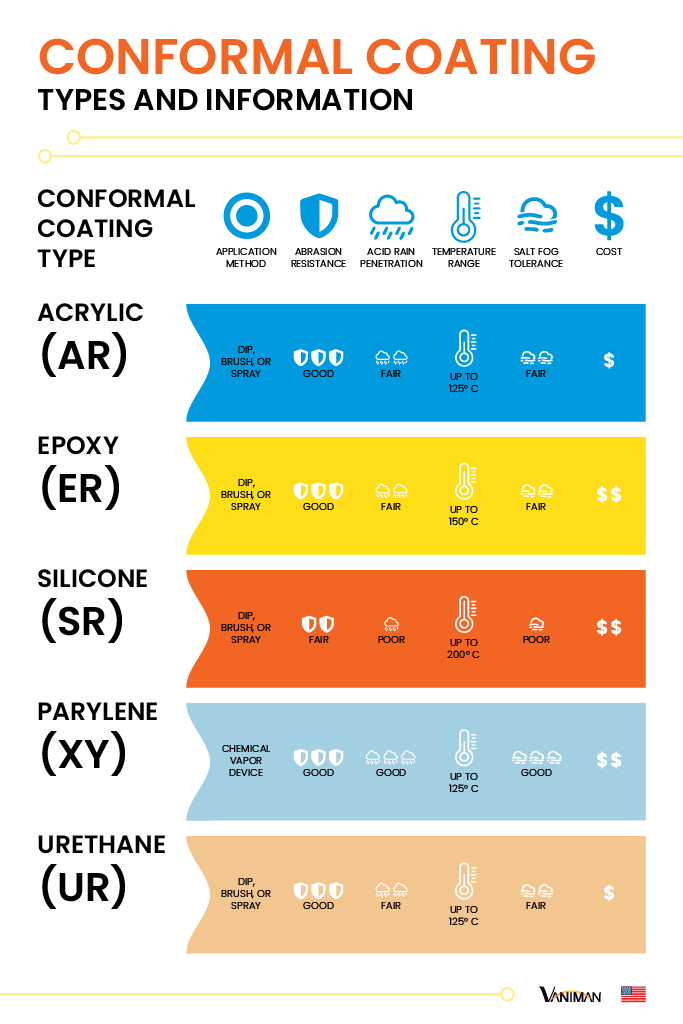
Chemical Solvent Method for Conformal Coating Removal
- Highly effective for removal of acrylic, silicone, and urethane printed circuit board coatings.
- A detailed process and guide for removal can be found in section 2.3.2 of the Circuit Technology Center’s (CTC) guide for coating removal
- Typically, you can prep the removal area using Kapton tape and apply the solvent using a foam swab as seen below.




Removal Procedure, Chemical Solvent Method
- Apply High-Temperature Tape to outline the area where the coating needs to be removed. Dip the end of a foam swab in stripping solution and apply a small amount to the coating to be removed.
Note
Since various substances may be used as coatings, the time required for a given coating to dissolve or soften will vary. Reapply solvent several times as most solvents evaporate rapidly.
- Rub the treated surface carefully with a brush or wood stick to dislodge the coating. A wedge-shaped applicator tip, knife, or heated blade may be effective in removing some coatings, particularly polyurethanes.
- Neutralize or clean the stripped area and dry.
Peeling Method for Conformal Coating Removal
- Normally used for RTV silicone or thick rubber coatings
- Use of a dull knife or blade is used to peel the coating from the circuit board.
- Removal procedure per CTC guide 2.3.3



Removal Procedure, Peeling Method
- Slit and peel off the coating material with a dull knife or heated dull blade.
- Repeat as needed until the required material is removed.
Thermal Method for Conformal Coating Removal
- Thermal removal involves the use of a low-temperature heat to gently burn and melt the coating.
- You’ll need to make sure to use a controlled low-temperature tool so as not to damage the PCB, so the use of a soldering iron is not recommended.
- Be wary as the fumes created by the burnout can be very harmful. Use proper ventilation or work under a Fume Hood for safety, or use a targeted fume extractor.
- Removal procedure per CTC guide 2.3.4



Removal Procedure, Thermal Method
- Select an appropriate thermal parting tip to suit the workpiece configuration. Set the nominal tip temperature, using the manufacturer’s recommended procedure.
- Apply the thermal parting tip to the coating, using a light pressure. The coating material will either soften or granulate. Polyurethanes will soften and epoxies will granulate. The tip temperature should be regulated to a point where it will effectively “break down” the coating without scorching or charring.
- Gradually reduce the coating thickness around the component body without contacting the board surface
Clip leads of component parts that are known to be faulty, thus permitting removal of the part body separately from leads and solder joints. Low-pressure air or a brush should be used to remove the loosened coating.
- Once sufficient coating has been removed, leaving only a small bonded joint between the part body and printed board, heat the component body with the thermal parting tool or hot air jet to weaken the bond beneath the component.
- Lift the component body free of the printed board using small pliers.
Note
Twist the component prior to removal to shear any remaining epoxy bond to the printed board surface.
- Once the component body has been removed from the board surface, the remaining coating material can be removed by additional thermal parting. The remaining leads and solder joints are then removed by appropriate solder extraction means.
Grinding and Scraping Method for Conformal Coating Removal
- Be careful, as the use of abrasion can cause excessive electrostatic discharge.
- The coating can be scraped away with a #16 blade knife
- Thin, hard coatings can be ground away using a rubber abrasive with a rotary-style tool or micro motor.
- Soft coatings can be ground away using a rotary brush.
- Procedure by CTC guide 2.3.5


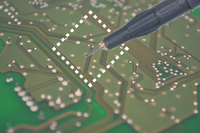

Removal Procedure, Grinding and Scraping Method
- Clean the area.
- Insert an abrasive tip into the handheld drill. Abrade away the damaged or unwanted coating. Move the tool from side to side to prevent damage to the circuit board surface.
- Remove all loose material and clean the area.
How To Remove Conformal Coating Using A Micro Sandblaster
A Micro Sandblaster can be used to carefully get rid of the conformal coating. Parylene, in particular, is difficult to remove using other methods due to its natural durability and therefore is often best removed using a micro blaster.
- Coating removal using a micro sandblaster involves a fine abrasive powder being projected onto the coating to flake-off the material.
- Make sure to use a micro blaster with ESD capabilities so as not to damage electrical components.
- Procedure by CTR guide section 2.3.6

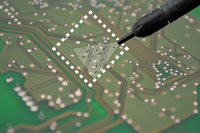

Removal Procedure, Sandblasting Method
- Clean the area.
- Select the appropriate abrasive blasting powder and nozzle size (see our sandblaster nozzle size chart here). Set the air pressure at the desired setting per equipment manufacturer’s instructions.
- Apply masking tape or other masking material to protect the circuit board surface as needed. Masking materials can consist of tapes, curable liquid masks or reusable stencils.
- If the circuit board has static sensitive components, insert the entire circuit board into a shielded bag. Only the area needing rework should be exposed. Ground the circuit board to dissipate static charges
- Insert the circuit board into the blasting chamber and blast away the damaged or unwanted coating\solder mask. Slowly move the nozzle along the area where the coating is to be removed.
- Blow off the blasting dust and clean the area.
Additionally, you can watch the video below on how to remove conformal coating with micro sandblaster.
Download a FREE quick-reference guide:
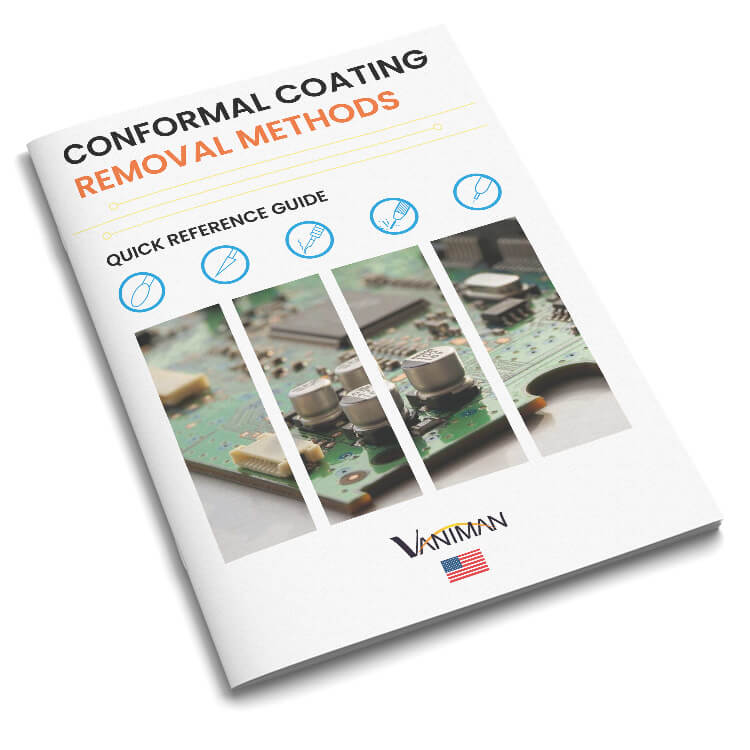
Tools & Equipment Links for Conformal Coating Removal
Micro Sandblaster (ESD resistant design)
Scraping and Testing Tools Kit
Micro Abrasive Sandblasting Media
Dust Collector For Micro-Sandblasters
-
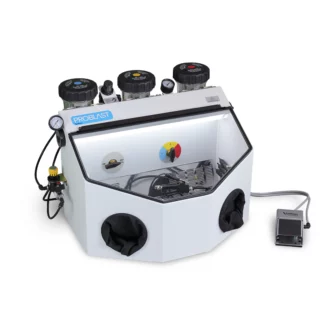 Master Problast 3 ESD – 80056$2,878.85View Details
Master Problast 3 ESD – 80056$2,878.85View Details -
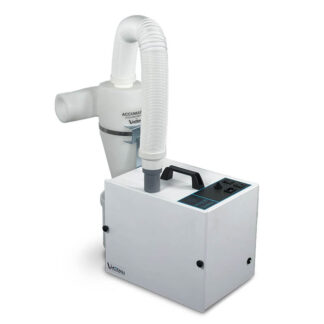 Abrasive Vac w/ Lg. Accumulator – 10660$974.46View Details
Abrasive Vac w/ Lg. Accumulator – 10660$974.46View Details -
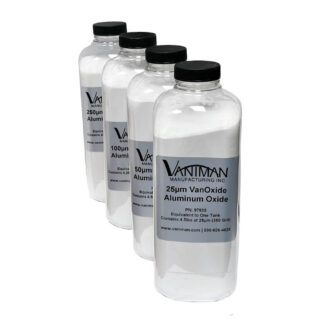 Sandblasting Media Sampler Packs$48.21 – $137.78View Details
Sandblasting Media Sampler Packs$48.21 – $137.78View Details



Have questions? No worries! Reach out to us at our contact page found in the footer area below and we’re happy to help you anyway we can.
[…] if you’re looking for something more in depth, check our Ultimate Guide to Conformal Coating Removal. […]
[…] […]